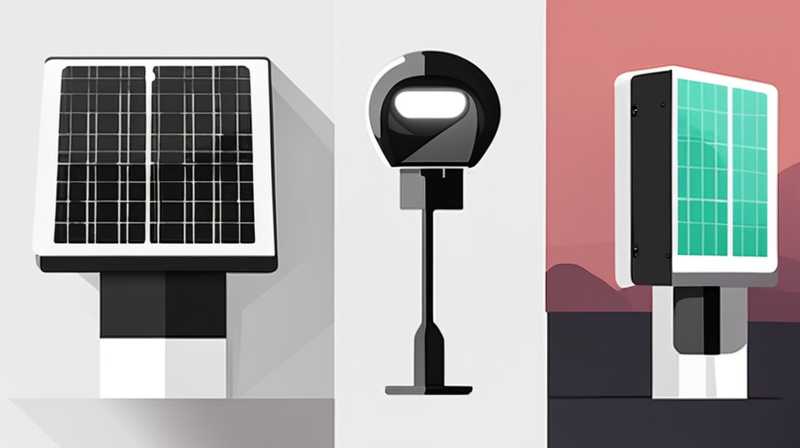
To adjust a solar integrated street light effectively, follow these key steps: 1. Identify the light’s features, 2. Determine the optimal angle for solar panels, 3. Adjust sensitivity settings of the motion sensor, 4. Regularly maintain the battery and LED components. The quality of the light and its energy efficiency largely depend on how well each component is set up. For instance, setting the solar panel to capture maximum sunlight can enhance charging efficiency, resulting in prolonged operational time during the night.
1. UNDERSTANDING SOLAR INTEGRATED STREET LIGHTS
Solar integrated street lights represent a transformative approach to outdoor illumination, blending energy efficiency with sustainability. These fixtures typically consist of a solar panel, LED lights, batteries, and several smart features such as motion sensors. Advantages of solar integrated street lights become evident when considering their installation; they eliminate the need for extensive wiring and trenching, therefore minimizing installation costs and environmental disruption.
Solar technology has progressed significantly, with modern panels boasting higher efficiency rates and improved battery storage capabilities. As urban areas demand innovative solutions for lighting, solar integrated models provide a reliable and eco-friendly alternative to traditional street lighting methods. Their independence from the electrical grid allows for installation in remote locations, significantly reducing energy costs and contributing to decreased carbon footprints. The adjustable nature of these systems further enhances their appeal, allowing users to optimize performance.
2. COMPONENT IDENTIFICATION AND FUNCTIONALITY
Recognizing the individual components of solar integrated street lights significantly aids in their efficient adjustment. Each light unit commonly consists of four critical parts: the solar panel, the LED light fixture, the battery, and a control system. Understanding how these components function together is essential for optimal performance.
SOLAR PANEL
The solar panel’s primary task is to capture sunlight and convert it into electrical energy. Proper positioning is key for efficiency; the panel should be oriented towards direct sunlight during peak hours. Users must also ensure there are no obstructions, such as trees or buildings, which could inhibit solar energy absorption. Seasonal changes in sunlight exposure could necessitate periodic adjustments.
LED LIGHTS AND CONTROL SYSTEM
The LED lights are designed to produce bright illumination while consuming minimal energy. The control system orchestrates the overall function of the street light, managing how and when the LED lights deactivate or activate based on the availability of natural light or detected motion. Understanding this interaction allows for fine-tuning settings, leading to enhanced energy savings.
3. OPTIMIZING THE ADJUSTMENT PROCESS
Adjustment encompasses various components, including angle settings, sensitivity levels, and battery maintenance routines. Each aspect plays a vital role in the operational effectiveness of solar integrated street light systems.
ANGLE OF SOLAR PANELS
Alterations to the angle of the solar panels directly influence their ability to harness sunlight. A general rule of thumb is to adjust panels according to geographic location: typically, panels should be tilted at an angle matching the latitude of the installation site. Also, during winter months, a higher angle helps compensate for the lower sun elevation in the sky.
SENSITIVITY SETTINGS
Sensors facilitate automatic adjustments to lighting based on environmental conditions. Careful calibration of sensitivity settings ensures that street lights illuminate only when needed, which prolongs the battery life and reduces energy consumption. As environmental factors, such as surrounding light and movement, can vary, regularly reviewing sensor settings is essential for optimal performance.
4. MAINTAINING BATTERY AND LED INTEGRITY
Regular maintenance is crucial in ensuring the longevity of solar integrated street lights. Battery health primarily dictates overall functionality, thereby directly impacting lighting hours. Users should routinely check battery levels and connections, replacing batteries as recommended by the manufacturer.
LED LIGHT INSPECTION
The LED components also require monitoring to ensure longevity and efficiency. Dirt and debris accumulation can greatly reduce light output, so periodic cleaning of the LED fixtures is a necessary step in the maintenance process. Additionally, users should assess the operational lifespan of the LEDs, replacing them as needed to maintain adequate illumination levels.
FREQUENTLY ASKED QUESTIONS
WHAT IS A SOLAR INTEGRATED STREET LIGHT?
Solar integrated street lights are outdoor lighting systems relying on solar energy. Equipped with photovoltaic panels, they convert sunlight into electricity, powering LED bulbs for illumination during nighttime. These fixtures have minimal environmental impact, reduce dependence on grid electricity, and lower installation costs. Additionally, they often include features like motion sensors and wireless monitoring systems for enhanced functionality.
HOW DO YOU ADJUST THE ANGLE OF A SOLAR PANEL?
Adjusting the solar panel angle involves loosening the mount to change the orientation. Ideally, the panel should face true south (in the Northern Hemisphere) to capture maximum sunlight. To determine the optimal tilt angle, consider the geographic location and seasonal sunlight variation. Use adjustment tools appropriately to reach the desired angle safely.
HOW OFTEN SHOULD I MAINTAIN SOLAR STREET LIGHTS?
Maintenance activities should occur at least twice a year to ensure light systems operate efficiently. Regular checks include inspecting battery health, cleaning the solar panel, and verifying the functionality of LED components. Post-storm conditions or extensive dirt accumulation may necessitate more frequent inspections to ensure reliability.
In summary, proficiently modifying solar integrated street lights hinges on meticulous assessment and adjustment of their components, which necessitates comprehensive knowledge about their functionalities. Proper positioning of solar panels, regular scrutiny of motion sensor settings, hydration of batteries, and thorough evaluation of LED fixtures contribute significantly to maximizing efficiency in performance. Staying informed about seasonal and environmental changes influences light operation quality, permits effective lighting based on necessity, and promotes sustainability. By adhering to structured maintenance and adjustment routines, one can ensure that these lights continue to provide reliable illumination well into the future, substantially benefiting localized communities.
Original article by NenPower, If reposted, please credit the source: https://nenpower.com/blog/how-to-adjust-the-solar-integrated-street-light/


